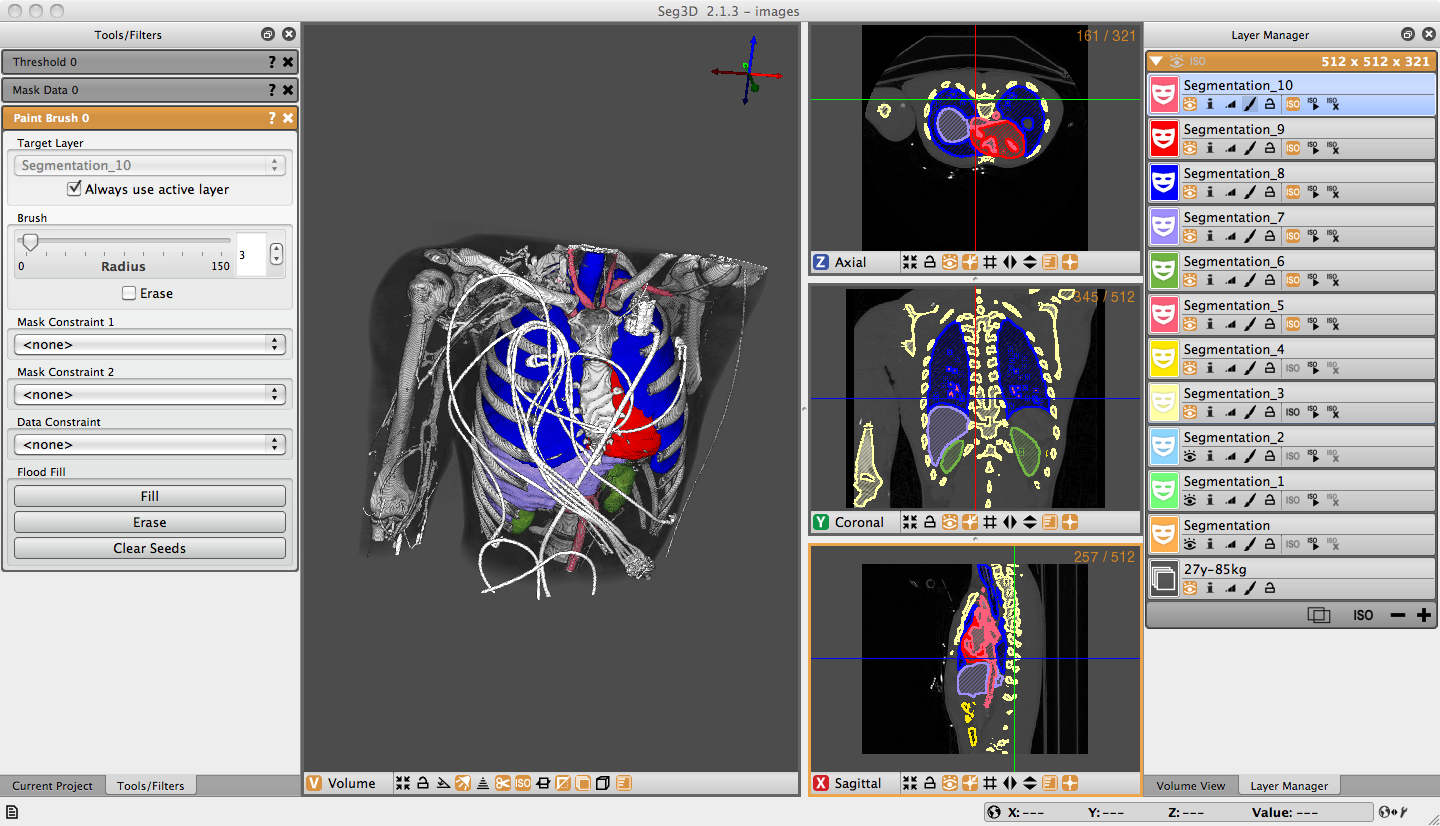 Seg3D is a free volume segmentation and processing tool developed by the NIH Center for Integrative Biomedical Computing at the University of Utah Scientific Computing and Imaging (SCI) Institute. Seg3D combines a flexible manual segmentation interface with powerful higher-dimensional image processing and segmentation algorithms from the Insight Toolkit. Users can explore and label image volumes using volume rendering and orthogonal slice view windows.
Seg3D is a free volume segmentation and processing tool developed by the NIH Center for Integrative Biomedical Computing at the University of Utah Scientific Computing and Imaging (SCI) Institute. Seg3D combines a flexible manual segmentation interface with powerful higher-dimensional image processing and segmentation algorithms from the Insight Toolkit. Users can explore and label image volumes using volume rendering and orthogonal slice view windows.
Seg3D at a glance:
- Fully 3D interface with multiple volumes managed as layers
- Automatic segmentation integrated with manual contouring
- Volume rendering with 2D transfer function manipulation in real-time
- Image processing and segmentation from the Insight Toolkit (ITK)
- Real time display of ITK filtering output allows for computational steering
- 64-bit enabled for handling large volumes on large memory machines
- Supports many common biomedical image formats
- Open source with BSD-style license
- Cross platform: Windows, OSX, and Linux
Please see the GitHub documentation pages for up-to-date installation and build documentation.
Acknowledgement: Seg3D is an Open Source software project that is principally funded through the SCI Institute's NIH/NIGMS CIBC Center. Please use the following acknowledgment and send us references to any publications, presentations, or successful funding applications that make use of NIH/NIGMS CIBC software or data sets.
"This project was supported by the National Institute of General Medical Sciences of the National Institutes of Health under grant numbers P41 GM103545 and R24 GM136986.”
• Seg3D Citation: [bibtex citation] [Endnote citation]
Seg3D is available for free and open source under the MIT License
Copyright (c) 2015 Scientific Computing and Imaging Institute, University of Utah.
Permission is hereby granted, free of charge, to any person obtaining a copy of this software and associated documentation files (the "Software"), to deal in the Software without restriction, including without limitation the rights to use, copy, modify, merge, publish, distribute, sublicense, and/or sell copies of the Software, and to permit persons to whom the Software is furnished to do so, subject to the following conditions:
The above copyright notice and this permission notice shall be included in all copies or substantial portions of the Software.
THE SOFTWARE IS PROVIDED "AS IS", WITHOUT WARRANTY OF ANY KIND, EXPRESS OR IMPLIED, INCLUDING BUT NOT LIMITED TO THE WARRANTIES OF MERCHANTABILITY, FITNESS FOR A PARTICULAR PURPOSE AND NONINFRINGEMENT. IN NO EVENT SHALL THE AUTHORS OR COPYRIGHT HOLDERS BE LIABLE FOR ANY CLAIM, DAMAGES OR OTHER LIABILITY, WHETHER IN AN ACTION OF CONTRACT, TORT OR OTHERWISE, ARISING FROM, OUT OF OR IN CONNECTION WITH THE SOFTWARE OR THE USE OR OTHER DEALINGS IN THE SOFTWARE.
NIH/NIGMS Center for Integrative Biomedical Computing Acknowledgment
CIBC software and the data sets provided on this web site are Open Source software projects that are principally funded through the SCI Institute's NIH/NCRR CIBC. For us to secure the funding that allows us to continue providing this software, we must have evidence of its utility. Thus we ask users of our software and data to acknowledge us in their publications and inform us of these publications. Please use the following acknowledgment and send us references to any publications, presentations, or successful funding applications that make use of the NIH/NCRR CIBC software or data sets we provide.
"This project was supported by the National Institute of General Medical Sciences of the National Institutes of Health under grant numbers P41 GM103545 and R24 GM136986.”




